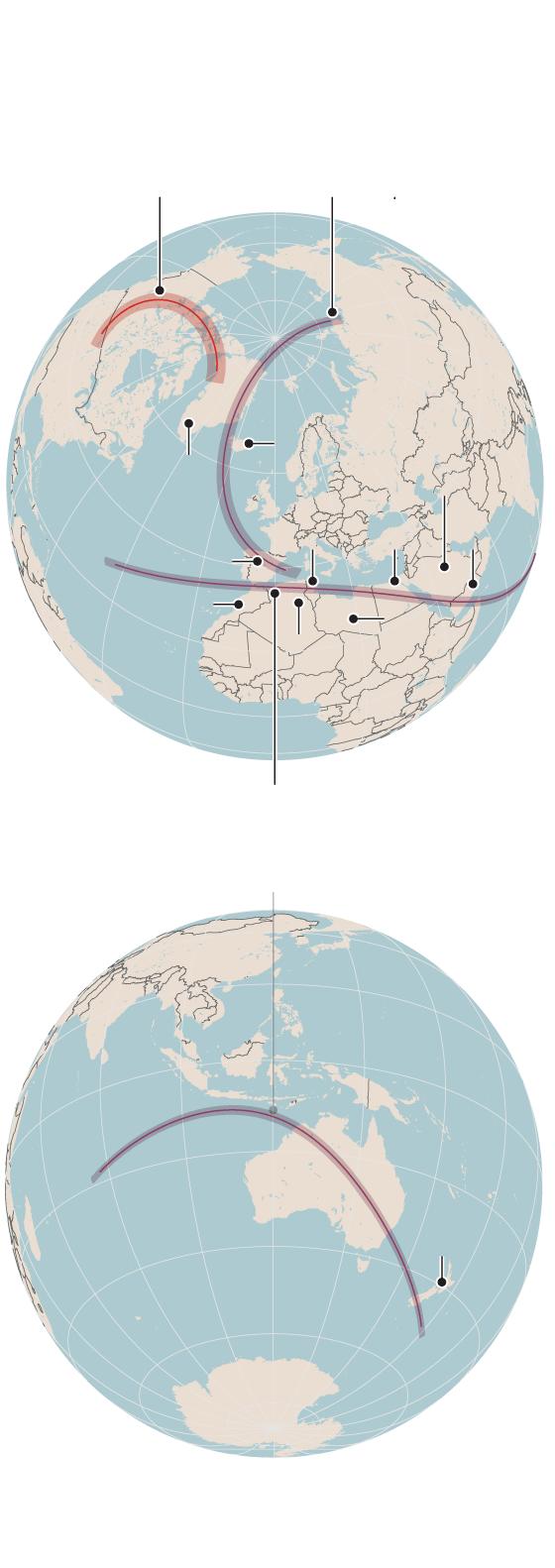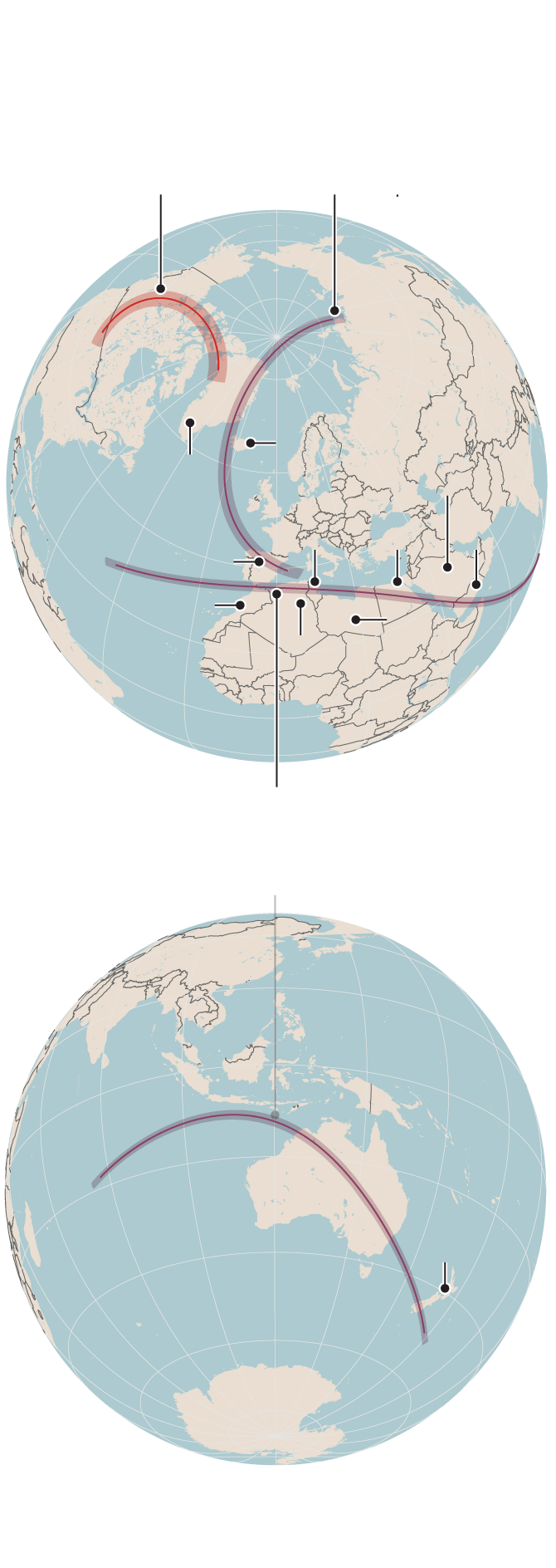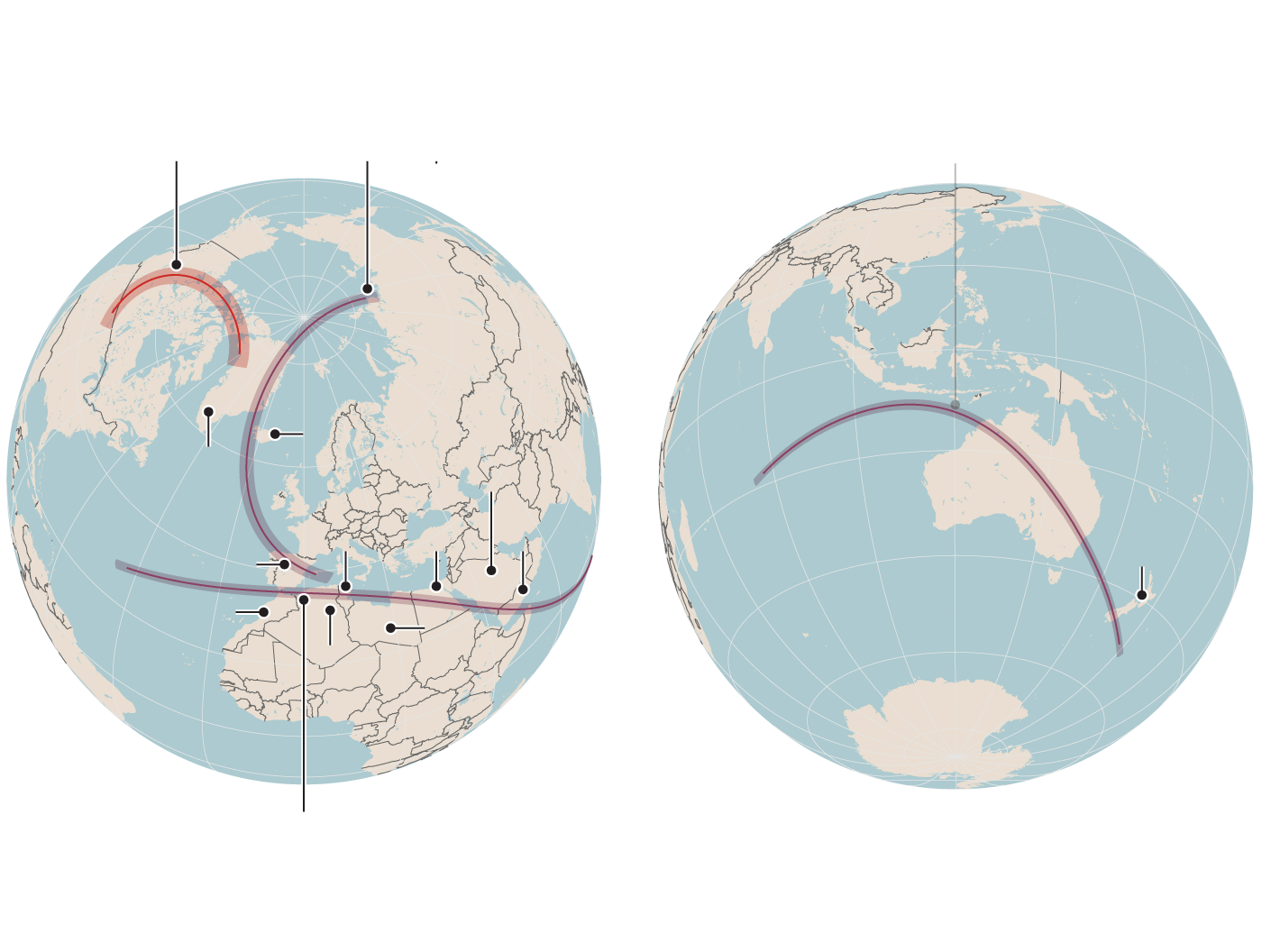A total solar eclipse is seen in Longyearbyen, Svalbard.Reuters
For eclipse chasers, the world is an observatory.
Iceland? Egypt? Australia? All three could be on your destination list in the next few years if you let the moon’s shadow act as your travel planner.
Of course, for many who live in Central and Eastern Canada, Monday, April 8 will offer the astronomical chance of a lifetime: seeing a total eclipse of the sun at home, or close to it.
On that day, a 180-kilometre wide patch of darkness will speed across the country from Point Pelee to the Niagara Peninsula, across Lake Ontario, down the St. Lawrence River to Montreal, over to Quebec’s Eastern Townships and then on to New Brunswick and Newfoundland.
How to watch a total solar eclipse
If you live within driving distance of any of these locations, it will never be easier to witness what is unquestionably one of the most spectacular sights in nature. Only in places along that path can observers watch the moon pass directly in front of the sun and momentarily block its light completely.
For a few fleeting minutes, the sky will darken and the sun’s extended outer atmosphere, the solar corona, will emerge like a heavenly aura around the moon’s black silhouette.
But what if it’s cloudy? For those on the path of totality who are under overcast skies, the surroundings will still darken to near-night levels. But the disappointment that comes with missing the main event could spark a desire to go further afield next time. Or – a happier thought – what if you see the total eclipse just as planned and reach the same conclusion as countless others before you: once in a lifetime is not enough.
The total eclipse peeked through clouds over Niagara Falls on Monday to give the huge crowds gathered there a view of the stellar phenomenon.
Fortunately, while total eclipses of the sun are quite rare in any one location, they happen all over the world at the rate of about five to six per decade. This creates plenty of opportunities to work eclipse chasing into a lifetime travel list, including trips to destinations that are alluring at any time.
Many travel companies are aware of the draw and offer packages or cruises that build an itinerary around a total eclipse. In addition to cost and ease of travel, factors to consider include weather prospects and duration of the total portion of the eclipse, which is greatest along the centre line of the path and at the halfway point of the shadow’s traverse across the globe.
To whet your appetite, here’s a list of total solar eclipses for the rest of this decade.

Paths of the next three total solar eclipses after April 8, 2024, plus Canada's next total
Aug. 23, 2044
Aug. 12, 2026
Russia
Canada
Iceland
Greenland
Saudi Arabia
Tunisia
Egypt
Yemen
Spain
Morocco
Libya
Algeria
Aug. 2, 2027
July 22, 2028
Australia
New
Zealand
MURAT YÜKSELIR / THE GLOBE AND MAIL,
SOURCE: TIMEANDDATE.COM

Paths of the next three total solar eclipses after April 8, 2024, plus Canada's next total
Aug. 23, 2044
Aug. 12, 2026
Russia
Canada
Iceland
Greenland
Saudi Arabia
Tunisia
Egypt
Yemen
Spain
Morocco
Libya
Algeria
Aug. 2, 2027
July 22, 2028
Australia
New
Zealand
MURAT YÜKSELIR / THE GLOBE AND MAIL,
SOURCE: TIMEANDDATE.COM

Paths of the next three total solar eclipses after April 8, 2024, plus Canada's next total
Aug. 23, 2044
Aug. 12, 2026
July 22, 2028
Russia
Canada
Iceland
Greenland
Saudi Arabia
Australia
New
Zealand
Tunisia
Egypt
Yemen
Spain
Morocco
Libya
Algeria
Aug. 2, 2027
MURAT YÜKSELIR / THE GLOBE AND MAIL, SOURCE: TIMEANDDATE.COM
Aug. 12, 2026
Maximum duration of total eclipse: 2 minutes 18 seconds
The first total eclipse of the sun after this month’s event starts at the edge of Siberia’s Taymyr Peninsula, but quickly crosses over the Arctic Ocean to Greenland. Near its maximum it skirts over western Iceland, including the capital, Reykjavik. But for those looking to view the eclipse where there is less herring and more sangria, the shadow next sweeps down to the north coast of Spain and crosses into the Mediterranean, where it can be viewed near sunset in Ibiza.
Aug. 2, 2027
Maximum duration of total eclipse: 6 minutes 23 seconds
This unusually long total eclipse starts in the mid Atlantic and then makes land fall on both sides of the Strait of Gibraltar. From there it mostly hugs the coast of Africa, crossing south of Tunis, Tunisia, and just touching Tripoli, Libya. But the real show stopper will come when the path of the shadow cuts across Egypt at its maximum duration, with its centre line passing over the ancient temples of Luxor. From there, the shadow crosses the Red Sea and into Saudi Arabia and Yemen before heading out into the Indian Ocean.
July 22, 2028
Maximum duration of total eclipse: 5 minutes 10 seconds
The final total solar eclipse of the 2020s is a southern hemisphere affair. It begins in the Indian Ocean, far to the east of Madagascar and encounters very little land until reaching the sparsely populated northwest side of Australia near it’s maximum point. From there it moves southward and across the island continent, eventually reaching Sydney, which, remarkably, sits squarely on the centre line of the eclipse. The shadow then moves across to New Zealand’s southern island where Dunedin is similarly well positioned as a place to watch the event.
What about Canada?
The 2030s feature six total solar eclipses, none of which come anywhere near Canada. The national drought finally ends on Aug. 23, 2044, when the moon’s shadow takes an unusual westward jaunt across the Arctic Archipelago before veering southward through the Northwest Territories and Alberta, capturing both Edmonton and Calgary in its path.